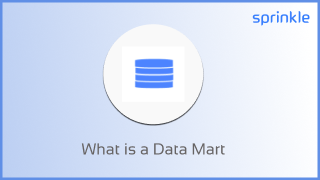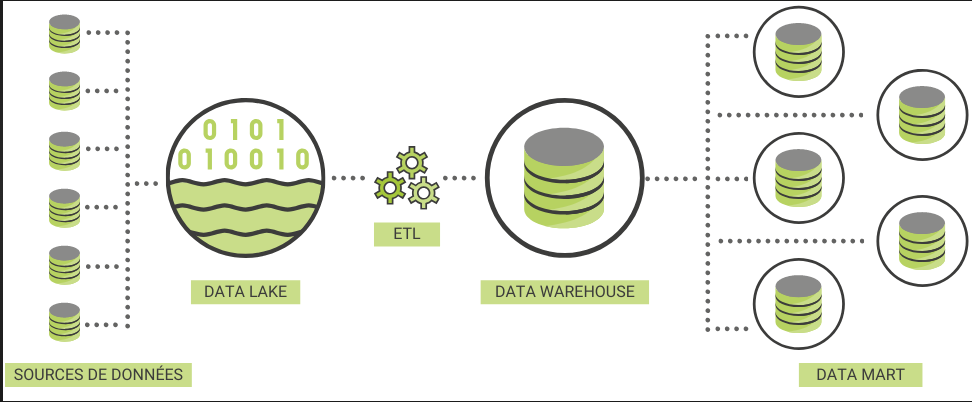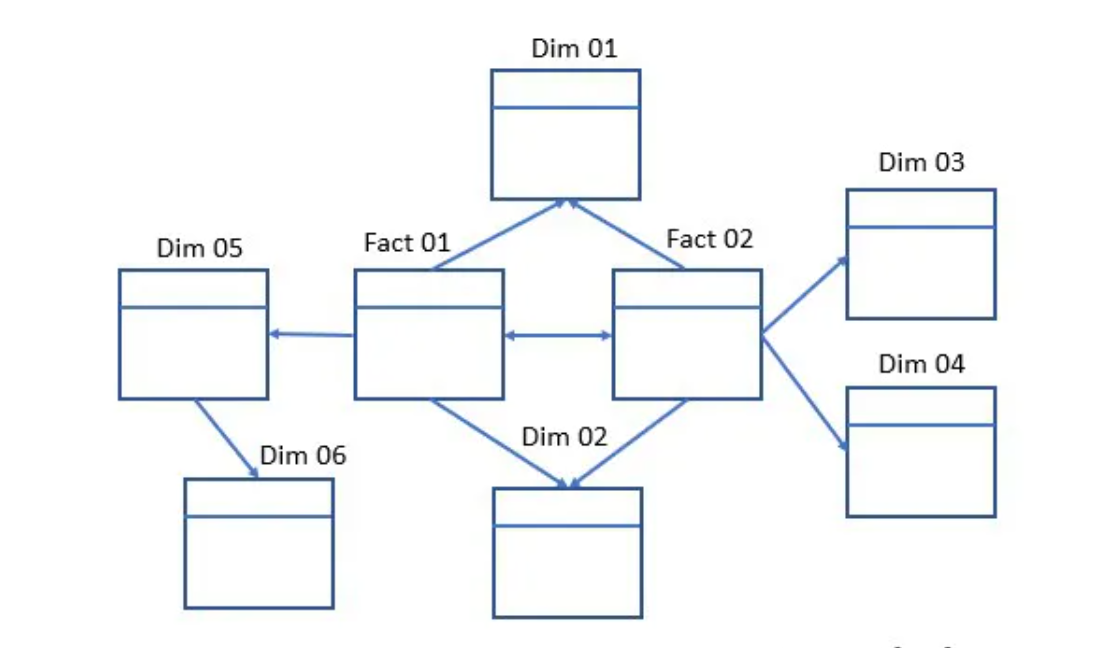
Introduction
Data management is a critical aspect of any organization's operations. As businesses collect and generate vast amounts of data, there is a need for efficient storage, processing, and analysis. This is where data marts come into play.
In this article, we will explore what they are, how they differ from data warehouses and data lakes, and why they are crucial for organizations aiming to leverage data-driven insights.
What is a data mart?
A data mart is a focused version of a data warehouse that contains a smaller subset of data that is important and needed by a single team of users within an organization like sales, finance, marketing, etc.
A data mart generally contains a well-defined set of data that is built from an existing data warehouse through an intricate procedure that involves multiple technologies and tools to design and construct a physical database, populate it with data, and set up access and management protocols. This process allows a specific business department to discover more focused insights to help the business users make clear and informed business decisions.

Benefits of Data mart
Implementing data marts within an organization offers several advantages:
- Enhanced Decision-Making: By providing focused and relevant business data, data marts empower businesses to make informed decisions quickly.
- Scalability: Data marts can be scaled independently, allowing organizations to start small and gradually expand their data infrastructure as needed. This ensures that resources are allocated efficiently and cost-effectively.
- Reduced Data Complexity: Data marts simplify the data landscape by breaking down complex datasets into smaller, more manageable units. This makes it easier for users to navigate and analyze data quickly.
- Increased Data Accessibility: Data marts help to access data quickly to specific user groups, reducing the need for cross-functional data sharing.
Types of Data Marts
Data marts can be classified into different types based on their relationship with the data warehouse and their underlying architecture. The three main types of data marts are listed below:
Dependent Data Marts
Dependent data marts are built directly from a centralized data warehouse. They share the same underlying architecture and schema as the data warehouse but contain a subset of data specific to a particular business unit.
Independent Data Marts
Independent data marts, as the name suggests, are standalone data marts that are not directly connected to a centralized data warehouse. They are built from various data sources, including transactional databases, external APIs, and flat files, and operate autonomously offering easy customization for specific business units. However, their independence can lead to data inconsistencies with the enterprise data warehouse.
Hybrid Data Marts
Hybrid data marts combine elements of both dependent and independent data marts. They are built from a combination of data sources, including the centralized data warehouse and external sources. Hybrid data marts leverage the advantages of both worlds - agility, and customization from local data and consistency and alignment with the enterprise data through integration with the warehouse.
Data Mart VS Data Warehouse VS Data Lake
While data warehouses, data lakes, and data marts serve as repositories for data, they serve different purposes within an organization.

Data Warehouse:
A data warehouse is a system that aggregates data from multiple sources into a single, central, consistent data store. Data warehouses consolidate data from different sources to make it available in one unified form.
Data Lake:
Data lakes are sprawling repositories of raw, semi-structured, and unstructured data that facilitate data storage. They do not require data to be processed or prepared for analysis before ingestion and they allow organizations to store vast amounts of data in its native format, providing invaluable flexibility and scalability.
Data Mart:
A data mart contains a subset of structured data that is important to and needed by a specific team or group of business users within an organization. Data mart is generally built from existing data warehouses or other data sources.
Choosing the Right Approach
When deciding between a data warehouse, data lake, and a data mart, organizations need to consider their specific requirements, budgets, and resources.
Data warehouses are suitable for organizations that require a centralized data repository, extensive data integration, and enterprise-wide analytics. They are typically more complex and expensive to implement.
Data lakes and data marts can complement each other in an organization's data architecture. Data lakes can serve as a central data repository, ingesting raw data from various sources and this raw data can then be processed, transformed, and loaded into data marts to provide focused insights for specific user groups.
Other distinguishing aspects between the three are listed in the table below:

Building a Data Mart
Building a data mart involves several steps, from data extraction to data governance and security. Let's delve deeper into the process and phases of constructing a data mart.
1. Rectifying Needs and Defining Scope:
The first step is to start by identifying the business objectives of the data mart. Clearly defining a goal like boosting sales, optimizing marketing campaigns, etc., will guide in proper data selection and structure.
Determining the scope of the data mart and identifying the affected business units will be the next step.
2. Data Gathering
Gathering data from reliable, consistent sources can add valuable context that will help to fuel your insights. Common options may include transactional data from CRM systems, ERP systems, external APIs, and other data repositories.
3. Designing Datamart Schema
The schema will define how the data in the data mart will be organized and structured. Some of the data mart schemas are discussed below:
- Star Schema: It has a simple structure where there is a central fact table that is surrounded by multiple dimension tables

image source- Snowflake Schema: It is similar to star schema but has additional branching out of dimension tables for more complex analysis.

image source- Galaxy Schema: It is a combination of both star schema and snowflake schema suitable for complicated data with diverse relationships.

4. Extract, Transform, Load (ETL):
- Extract: Extraction of data includes pulling data from the selected sources.
- Transform: Once the data is extracted, it needs to be transformed into a format suitable for analysis and storage within the data mart. This process involves cleansing, filtering, and standardizing the data to ensure consistency, and quality and to remove any data redundancy if exists.
- Load: After the data is transformed, it needs to be loaded into the data mart. This can be done through various methods such as batch processing, real-time streaming, or incremental updates. The loading process involves mapping the summarized data to the data mart's schema and populating the database tables.
5. Data Governance and Security
Data governance and security are crucial aspects of data mart construction. This involves implementing role-based access controls, data encryption, data masking, and monitoring mechanisms to prevent unauthorized access and ensure data integrity.
Implementing Data Marts
Implementing data marts requires careful planning, and adherence to best practices such as defining a data strategy, adopting a data modeling approach, establishing robust data integration processes, and managing the data quality
Challenges
Implementing data marts can come with its own set of challenges. Some common challenges organizations may face includes:
- Ensuring data governance and security across multiple data marts can be complex.
- Integrating data from multiple sources into a cohesive data mart architecture can be challenging.
- Maintaining data consistency between the data warehouse and data marts is crucial.
To overcome these challenges proper structured and well-planned tools and technologies could be used. They can aid in the easy implementation of data marts, some of them are mentioned below:
ETL Tools: Extract, Transform, Load (ETL) can facilitate data extraction, transformation, and loading processes. Some of the ETL tools are mentioned below:
- Sprinkle Data
- Informatica PowerCenter
- Talend
- Hevo Data
Data Integration Platforms: Data integration platforms can help streamline data integration across various sources and data marts. Some of them include :
- Microsoft Azure Data Factory
- IBM InfoSphere DataStage
- Apache Kafka
Conclusion
Data marts play a crucial role in enabling organizations to derive valuable insights from their data. Whether as standalone solutions or as part of a larger data warehouse architecture, data marts offer flexibility, scalability, and improved performance.
Frequently Asked Questions FAQs - What is a Data mart?
- What is a data mart, and how does it differ from an enterprise data warehouse?
A data mart is a subset of a data warehouse or external data sources that focuses on specific business functions or user groups. It varies from a data warehouse in that it is more targeted, containing data tailored to the analytical needs of a particular division or business unit. - How many types of data marts are there?
There are three types of different data marts :
- Dependent data mart: It draws data directly from a centralized data warehouse.
- Independent data mart: It is created and maintained separately from the central data warehouse.
- Hybrid data mart: It incorporates features of both dependent and independent data marts.
- What is a data warehouse?
A data warehouse is a centralized repository that stores large volumes of structured historical data from various sources within an organization. - What are the advantages of a data mart?
- Focused Insights: It provides targeted and precise data for a particular business unit.
- Efficient Access: It enables fast and immediate access to relevant data, enhancing query performance.
- Structured data: Data stored in a data mart is structured as it is derived from an existing data warehouse.
- What are the disadvantages of a data mart?
- Consistency Challenges: Maintaining consistency with the central data warehouse can be challenging.
- Integration Complexity: Integration with other data sources and the broader data architecture may be complex.
- What is an example of a data mart?
A retail company can create a data mart specifically for sales and marketing teams. This data mart can provide insights into customer behavior, sales trends, etc. By having access to focused and relevant data, sales and marketing teams can easily make data-driven decisions - What is the difference between a database and a data mart?
A database is a comprehensive storage system for diverse organizational data, while a data mart is a specialized subset designed to provide targeted access and analytics for a specific business area or department. - How to create a data mart?
To create a data mart, define the data requirements, extract relevant data from the central data warehouse or source systems, transform and structure the data to suit analytical needs, and finally load it into a separate repository optimized for quick access. - Are data marts expensive?
The cost of data marts can vary, affected by factors like size, technology, and integration intricacies, but they are often designed to be more cost-effective than data warehouses. - Why do we need data mart?
Data marts are required to provide focused and efficient solutions for quick access to relevant data to enhance the decision-making process using proper business intelligence (BI) tools, within specific business units.












